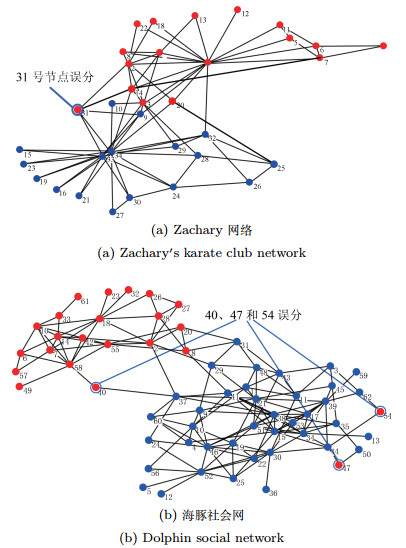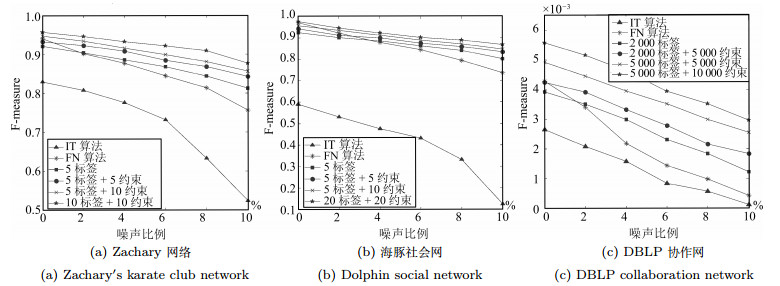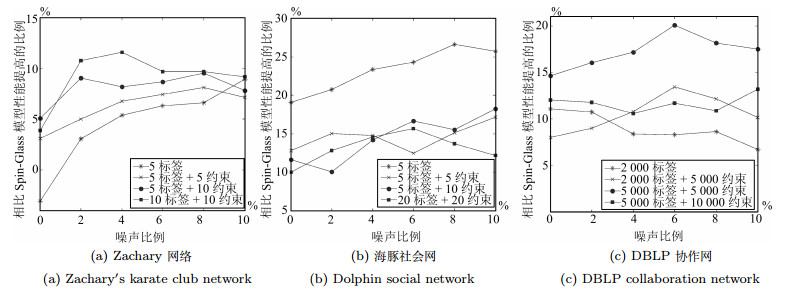|
[1]
|
Fortunato S. Community detection in graphs. Physics Reports, 2010, 486(3-5):75-174 doi: 10.1016/j.physrep.2009.11.002
|
|
[2]
|
Eaton E, Mansbach R. A spin-glass model for semi-supervised community detection. In:Proceedings of the 26th AAAI Conference on Artificial Intelligence. Toronto, Ontario, Canada:AAAI, 2012:900-906
|
|
[3]
|
Newman M E J, Girvan M. Finding and evaluating community structure in networks. Physical Review E, 2004, 69(2):026113-1-026113-15 https://compepi.cs.uiowa.edu/uploads/Readings/Newman04/newman04.pdf
|
|
[4]
|
Good B H, De Montjoye Y A, Clauset A. Performance of modularity maximization in practical contexts. Physical Review E, 2010, 81(4):046106-1-046106-19 http://tuvalu.santafe.edu/~aaronc/courses/7000/readings/Good_Montjoye_Clauset_10_PerformanceOfModularityMaximizationInPracticalContexts.pdf
|
|
[5]
|
Yang Z, Tang J, Li J Z, Yang W J. Social community analysis via a factor graph model. IEEE Intelligent Systems, 2011, 26(3):58-65 doi: 10.1109/MIS.2010.55
|
|
[6]
|
Girvan M, Newman M E J. Community structure in social and biological networks. Proceedings of the National Academy of Sciences of the United States of America, 2002, 99(12):7821-7826 doi: 10.1073/pnas.122653799
|
|
[7]
|
Brandes U, Delling D, Gaertler M, Gorke R, Hoefer M, Nikoloski Z, Wagner D. On modularity clustering. IEEE Transactions on Knowledge and Data Engineering, 2008, 20(2):172-188 doi: 10.1109/TKDE.2007.190689
|
|
[8]
|
Newman M E J. Fast algorithm for detecting community structure in networks. Physical Review E, 2004, 69(6):066133 doi: 10.1103/PhysRevE.69.066133
|
|
[9]
|
Duch J, Arenas A. Community detection in complex networks using extremal optimization. Physical Review E, 2005, 72(2):027104 doi: 10.1103/PhysRevE.72.027104
|
|
[10]
|
Guimerá R, Amaral L A N. Functional cartography of complex metabolic networks. Nature, 2005, 433(7028):895-900 doi: 10.1038/nature03288
|
|
[11]
|
White S, Smyth P. A spectral clustering approach to finding communities in graph. In:Proceedings of the 2005 International Conference on Data Mining. New York, USA:IEEE, 2005, 5:76-84
|
|
[12]
|
Guimerá R, Sales-Pardo M, Amaral L A N. Modularity from fluctuations in random graphs and complex networks. Physical Review E, 2004, 70(2):025101-1-025101-4 https://archive.org/details/arxiv-cond-mat0403660
|
|
[13]
|
Fortunato S, Barthélemy M. Resolution limit in community detection. Proceedings of the National Academy of Sciences of the United States of America, 2007, 104(1):36-41 doi: 10.1073/pnas.0605965104
|
|
[14]
|
Shen H W, Cheng X Q, Fang B X. Covariance, correlation matrix, and the multiscale community structure of networks. Physical Review E, 2010, 82(1):016114-1-016114-9 https://www.researchgate.net/publication/46423234_Covariance_correlation_matrix_and_the_multiscale_community_structure_of_networks
|
|
[15]
|
Palla G, Derényi I, Farkas I, Vicsek T. Uncovering the overlapping community structure of complex networks in nature and society. Nature, 2005, 435(7043):814-818 doi: 10.1038/nature03607
|
|
[16]
|
Palla G, Barabási A L, Vicsek T. Quantifying social group evolution. Nature, 2007, 446(7136):664-667 doi: 10.1038/nature05670
|
|
[17]
|
Mucha P J, Richardson T, Macon K, Porter M A, Onnela J-P. Community structure in time-dependent, multiscale, and multiplex networks. Science, 2010, 328(5980):876-878 doi: 10.1126/science.1184819
|
|
[18]
|
Ma X K, Gao L, Yong X R, Fu L D. Semi-supervised clustering algorithm for community structure detection in complex networks. Physica A:Statistical Mechanics and its Applications, 2010, 389(1):187-197 doi: 10.1016/j.physa.2009.09.018
|
|
[19]
|
Allahverdyan A E, Ver Steeg G, Galstyan A. Community detection with and without prior information. EPL (Europhysics Letters), 2010, 90(1):983-995 http://www.academia.edu/2814591/Community_detection_with_and_without_prior_information
|
|
[20]
|
Liu D, Liu X, Wang W J, Bai H Y. Semi-supervised community detection based on discrete potential theory. Physica A:Statistical Mechanics and its Applications, 2014, 416:173-182 doi: 10.1016/j.physa.2014.08.051
|
|
[21]
|
Li L, Du M, Liu G F, Hu X G, Wu G Q. Extremal optimization-based semi-supervised algorithm with conflict pairwise constraints for community detection. In:Proceedings of the 2014 IEEE/ACM International Conference on Advances in Social Networks Analysis and Mining. New York, USA:IEEE, 2014. 180-187
|
|
[22]
|
Yang L, Cao X C, Jin D, Wang X, Meng D. A unified semi-supervised community detection framework using latent space graph regularization. IEEE Transactions on Cybernetics, 2014, 45(11):2585-2598 https://www.researchgate.net/publication/269933321_A_Unified_Semi-Supervised_Community_Detection_Framework_Using_Latent_Space_Graph_Regularization
|
|
[23]
|
Yang L, Jin D, Wang X, Cao X C. Active link selection for efficient semi-supervised community detection. Scientific Reports, 2015, 5:9039-1-9039-12 https://www.researchgate.net/profile/Xiao_Wang44/publication/273468099_Active_link_selection_for_efficient_semi-supervised_community_detection/links/5530287b0cf20ea0a06f665d.pdf?inViewer=true&pdfJsDownload=true&disableCoverPage=true&origin=publication_detail
|
|
[24]
|
Tang W B, Zhuang H L, Tang J. Learning to infer social ties in large networks. Machine Learning and Knowledge Discovery in Databases. Berlin Heidelberg:Springer, 2011, 6913:381-397 doi: 10.1007/978-3-642-23808-6_25?no-access=true
|
|
[25]
|
Hammersley J M, Clifford P. Markov fields on finite graphs and lattices. 1971. http://www.oalib.com/references/16301575
|
|
[26]
|
Geman S, Geman D. Stochastic relaxation, Gibbs distributions, and the Bayesian restoration of images. IEEE Transactions on Pattern Analysis and Machine Intelligence, 1984, 6(6):721-741 http://www.ncbi.nlm.nih.gov/pubmed/22499653
|
|
[27]
|
Basu S, Bilenko M, Mooney R J. A probabilistic framework for semi-supervised clustering. In:Proceedings of the 10th ACM SIGKDD International Conference on Knowledge Discovery and Data Mining. New York, USA:ACM, 2004. 59-68
|
|
[28]
|
Kleinberg J, Tardos É. Approximation algorithms for classification problems with pairwise relationships:Metric labeling and Markov random fields. Journal of the ACM, 2002, 49(5):616-639 doi: 10.1145/585265.585268
|
|
[29]
|
Murphy K P, Weiss Y, Jordan M I. Loopy belief propagation for approximate inference:an empirical study. In:Proceedings of the 15th Conference on Uncertainty in Artificial Intelligence. San Francisco, CA, USA:Morgan Kaufmann Publishers Inc., 1999. 467-475
|
|
[30]
|
Lusseau D, Schneider K, Boisseau O J, Haase P, Slooten E, Dawson S M. The bottlenose dolphin community of doubtful sound features a large proportion of long-lasting associations. Behavioral Ecology and Sociobiology, 2003, 54(4):396-405 doi: 10.1007/s00265-003-0651-y
|
|
[31]
|
Yang J, Leskovec J. Defining and evaluating network communities based on ground-truth. Knowledge and Information Systems, 2015, 42(1):181-213 doi: 10.1007/s10115-013-0693-z
|
|
[32]
|
Basu S. Semi-supervised Clustering:Probabilistic Models, Algorithms and Experiments[Ph.D. dissertation], University of Texas at Austin, USA, 2005.
|
|
[33]
|
Rosvall M, Bergstrom C T. An information-theoretic framework for resolving community structure in complex networks. Proceedings of the National Academy of Sciences of the United States of America, 2007, 104(18):7327-7331 doi: 10.1073/pnas.0611034104
|





 下载:
下载:







